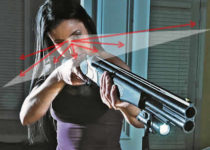Marksmanship vs Point Index Shooting Training Methods
Which is Best for the Beginner?
Story and Photos by Paul PawelaThe debate rages among gun aficionados on how to train beginners on the fine points of shooting a handgun. Some trainers start out with the fundamentals of marksmanship:
- Steady hold;
- Proper breathing;
- Focus on the front sight;
- Practice rear sight alignment and Gently squeeze (don’t jerk) the trigger
- Crush grip on the gun;
- ) Center line the body and index the firearm straight to eye-level as you’re pointing a finger looking over the sights, not looking through them
- ) Shoulder and pelvis are slightly bent in a good fighting stance with the arms extended and locked out;
- When shooting begins, never regrip the gun or lower to see where your hits are. Shoot three to four groups at whatever distance (no longer than 30 feet) before verifying the target.

marksmanship training takes “a significant amount of practice to
fully master,” a big ask in a time of bullet shortages, while point index
shooting is all about just “getting multiple hits rapidly on target.
Marksmanship focuses on target shooting, while point index shooting emphasizes shooting for self-defense, which greatly differs from poking holes into targets.

TARGET VS. TACTICAL SHOOTING Personally, I favor point index shooting if we’re talking handguns because it was designed for up-close self-defense situations. Time and again, we find what works well for target shooting bears little resemblance to a tactical shooting situation.
One of my first shooting instructors/mentors was retired Command Sergeant Major Eric Haney (he was an active duty master sergeant when I trained with him and I was a sergeant). He was one of the original members of Delta Force and the author of Inside Delta Force, the book that inspired the popular television show The Unit. To quote Haney from his book:
“Pistols are a trade-off, trading range and accuracy for portability and concealability. … Most shooting is based on methods used in target shooting – staring at the front sight. Close range gun fighting is a world away from target shooting.” Consider that in the majority of citizen-involved self-defense shootings, most conflicts occur within arm’s reach, with the longest distance being about 30 feet or the length of two cars (the car is the number one location for assaults on citizens). However, many people waste bullets and time trying to hone skills with handguns at absurd distances from 25 to 100 yards. Spend time training for what is probable, not possible.
Under stress in a fight or flight situation, the body will instinctively crouch and subconsciously push away from the danger by creating distance. If armed, you will automatically crouch and extend your arms, placing them at eye-level.
So why not practice this method even before you begin the basic marksmanship techniques? It will create confidence, which leads to practical experience.

Historically, the fundamentals of marksmanship originated with rifle shooting. The theory was that if armed with a rifle, one has distance, and if there is distance, there is time: time to focus on breathing, time to get proper front sight/rear sight alignment, time to slowly squeeze the trigger.
These are all the things one needs to do to become a competitive shooter or a distinguished marksman. Unfortunately, this training is commonplace for handguns as well, and it takes a significant amount of practice to fully master. In the process, new shooters often develop “target fixation” and are frustrated by the inability to constantly hit the bull’s-eye.
EASY-TO-MASTER METHOD
The point index shooting method I prefer is the same, whether you are shooting two-handed or one-handed, in the case of a person holding onto a loved one or dealing with an injured hand during the course of a deadly encounter.
In fact, I am so confident of this method that I often bet my students a steak dinner that I can have them shooting proficiently in five minutes or less; in the last 12 years, I have taught over 6,000 people this method and have not had to buy one dinner!
I care far less about grouping targets than I do about getting multiple hits rapidly on target because at the end of the day, we are concerned with stopping the threat. That means to shoot as many rounds as needed. When a person can put their rounds inside the number 10 target ring, that gives us confidence.
Marksmanship can come later. A handgun is a self-preservation tool used at close distances; gunfighting is a world away from target shooting. If you’re a new shooter, why not train for the worst-case scenario first? That’s just my two cents.
Editor’s note: Paul Pawela is a nationally recognized firearms and self-defense expert.



